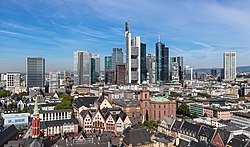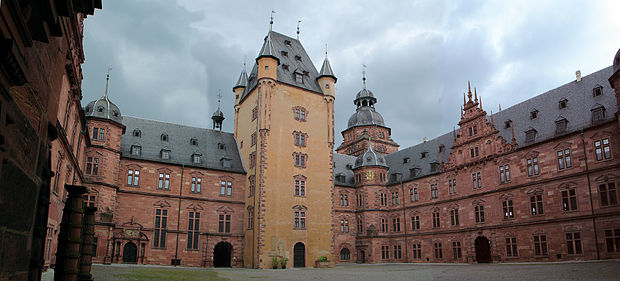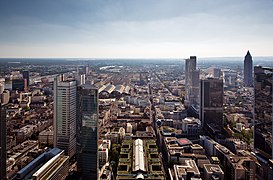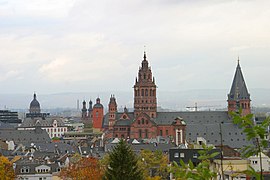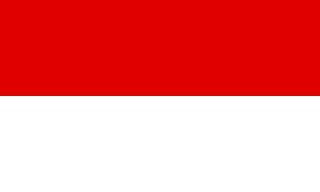
Hesse or Hessia, officially the State of Hesse, is a state in Germany. Its capital city is Wiesbaden, and the largest urban area is Frankfurt, which is also the country's principal financial centre. Two other major historic cities are Darmstadt and Kassel. With an area of 21,114.73 square kilometers and a population of over six million, it ranks seventh and fifth, respectively, among the sixteen German states. Frankfurt Rhine-Main, Germany's second-largest metropolitan area, is mainly located in Hesse.

Wiesbaden is the capital of the German state of Hesse, and the second-largest Hessian city after Frankfurt am Main. With around 283,000 inhabitants, it is Germany's 24th-largest city. Wiesbaden forms a conurbation with a population of around 500,000 with the neighbouring city of Mainz. This conurbation is in turn embedded in the Rhine-Main Metropolitan Region—Germany's second-largest metropolitan region after Rhine-Ruhr—which also includes the nearby cities of Frankfurt am Main, Darmstadt, Offenbach am Main, and Hanau, and has a combined population exceeding 5.8 million.

Darmstadt is a city in the state of Hesse in Germany, located in the southern part of the Rhine-Main-Area. Darmstadt has around 160,000 inhabitants, making it the fourth largest city in the state of Hesse after Frankfurt am Main, Wiesbaden, and Kassel.
Offenbach is a Kreis (district) in the south of Hesse, Germany and is part of the Frankfurt/Rhine-Main Metropolitan Region. Neighbouring districts are Main-Kinzig, Aschaffenburg, Darmstadt-Dieburg, Groß-Gerau and the cities of Darmstadt, Frankfurt and Offenbach.
Main-Taunus is a Kreis (district) in the middle of Hessen, Germany and is part of the Frankfurt/Rhine-Main Metropolitan Region as well as the Frankfurt urban area. Neighboring districts are Hochtaunuskreis, district-free Frankfurt, Groß-Gerau, district-free Wiesbaden, Rheingau-Taunus. It is the second most densely populated rural district in Germany.
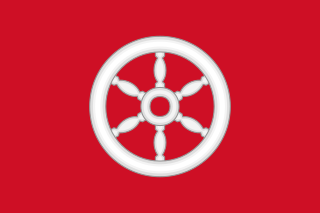
The Electorate of Mainz, previously known in English as Mentz and by its French name Mayence, was one of the most prestigious and influential states of the Holy Roman Empire. In the Roman Catholic hierarchy, the Archbishop-Elector of Mainz was also the Primate of Germany, a purely honorary dignity that was unsuccessfully claimed from time to time by other archbishops. There were only two other ecclesiastical Prince-electors in the Empire: the Electorate of Cologne and the Electorate of Trier.
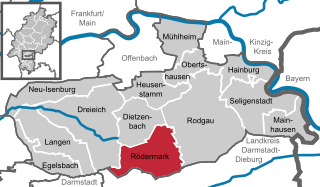
Rödermark is a town in the Offenbach district in the Regierungsbezirk of Darmstadt in Hesse, Germany, southeast of Frankfurt am Main and northeast of Darmstadt.
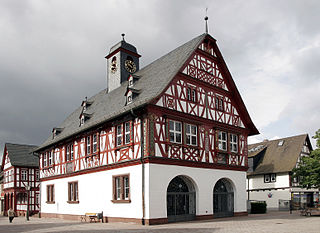
Groß-Gerau is the district seat of the Groß-Gerau district, lying in the southern Frankfurt Rhein-Main Region in Hesse, Germany, and serving as a hub for the surrounding area. In 1994, the town hosted the 34th Hessentag state festival.

The Rhine-Neckar Metropolitan Region, often referred to as Rhein-Neckar-Triangle, is a polycentric metropolitan region located in south western Germany, between the Frankfurt/Rhine-Main region to the North and the Stuttgart Region to the South-East.

Mainz Hauptbahnhof is a railway station for the city of Mainz in the German state of Rhineland-Palatinate. It is used by about 60,000 travelers and visitors each day and is therefore by far the busiest station in Rhineland-Palatinate. The station was a trial area for a CCTV scheme using automated face recognition.

The Taunus Railway is a double-track electrified railway line, which connects Frankfurt and Wiesbaden, Germany. It is 41.2 km long and follows the course of the Main on its north side, running quite close to it in some places. Its first stage was opened in September 1839 and is thus the oldest railway line in the German state of Hesse and one of the oldest in Germany. Today it is used by Regional-Express trains between Frankfurt and Wiesbaden and the trains of line S1 of the Rhine-Main S-Bahn between Frankfurt-Höchst and Wiesbaden. Between Frankfurt Hbf and Frankfurt-Höchst, they run on the line of the former Hessian Ludwig Railway.

The Hessian Ludwig Railway or HLB with its network of 697 kilometres of railway was one of the largest privately owned railway companies in Germany.
The Rhine-Main Railway, is a railway line in southern Germany from Mainz via Darmstadt to Aschaffenburg. It was built by the Hessian Ludwig Railway and opened on 1 August 1858 and is one of the oldest railways in Germany. Until 1862, when the railway bridge over the Rhine river constructed and assembled by MAN-Werk Gustavsburg was finished, a train ferry operated on the river.

Rüsselsheim station is a transit station in the town of Rüsselsheim in the German state of Hesse on the Main Railway from Mainz to Frankfurt am Main. It is classified by Deutsche Bahn as a category 3 station. The station is served by the Rhine-Main S-Bahn and by regional trains. There is another station in Rüsselsheim, Rüsselsheim-Opelwerk station, which is served by S-Bahn trains only.

Mainz-Bischofsheim station is the station of the town of Bischofsheim in the German state of Hesse on the Main Railway from Mainz to Frankfurt am Main. It is classified by Deutsche Bahn as a category 4 station. The station is served by the S-Bahn and regional trains. The station was opened at its current location in 1904.

Mainz-Gustavsburg station is the station of the town of Ginsheim-Gustavsburg in the German state of Hesse on the Main Railway from Mainz to Frankfurt am Main. It is classified by Deutsche Bahn as a category 5 station. The station is served by the S-Bahn and some regional trains. The station was opened at its current location in 1858.

Groß Gerau station is located approximately 500 metres north of the centre of the town of Groß-Gerau in the German state of Hesse on the Rhine-Main Railway, running from Wiesbaden and Mainz to Darmstadt and Aschaffenburg. A curve branches off near the station connecting to the nearby Groß-Gerau-Dornberg station on the Mannheim–Frankfurt railway. The station is classified by Deutsche Bahn as a category 5 station. The station name has no hyphen unlike the town it is in, following a Prussian government order of 1910, which applied because of Prussian finance for the line, even though the station was in the Grand Duchy of Hesse.

Darmstadt Nord (north) station is a junction station in the city of Darmstadt in the German state of Hesse. The passenger station, which is served by trains of the Odenwald Railway and the Rhine-Main Railway (Rhine-Main-Bahn), has four platform tracks. Running parallel and north of the station are two additional tracks for freight traffic.
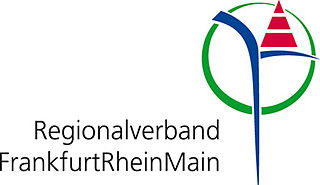
The Regional Authority of Frankfurt Rhein-Main is the cooperation body of the administratively fragmented Frankfurt am Main urban area and the common authority for Frankfurt am Main and its 75 neighboring communities. It manages and coordinates the regional development of Frankfurt am Main and its suburbs. It also represents the Frankfurt urban area nationally and internationally and is responsible for the strategic alignment of the local decision-making, for the development of a common regional image and an improved regional harmonisation. The authority draws up and updates the regional preparatory land use plans, local development and zoning plans, and carries out an intensive regional monitoring to coordinate the development of the urban region.
The IT cluster Rhine-Main-Neckar, also known as Silicon Valley of Germany, is one of the most important locations of the IT and high-tech industry worldwide. It is concentrated in the Rhine-Main and Rhine-Neckar metropolitan regions. The IT cluster Rhine-Main-Neckar is the largest IT cluster in Europe. 50 percent of the worldwide revenue of the hundred largest European software companies is generated by companies in this region. The Rhine-Main-Neckar region also has one of the most important biopharmaceutical, fintech, finance and consulting clusters in Europe.
